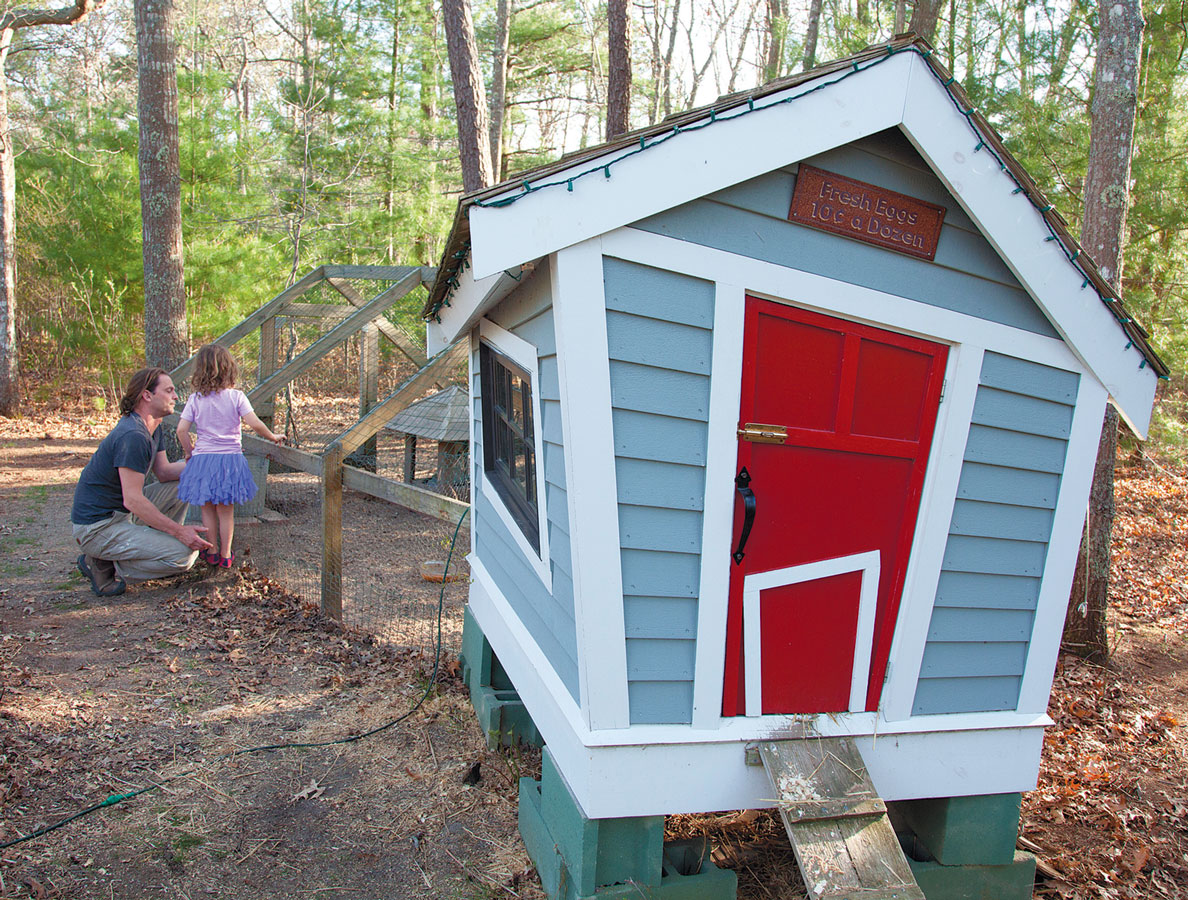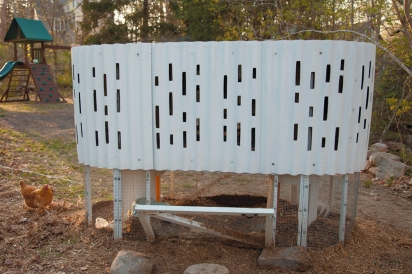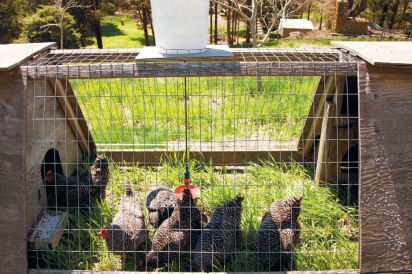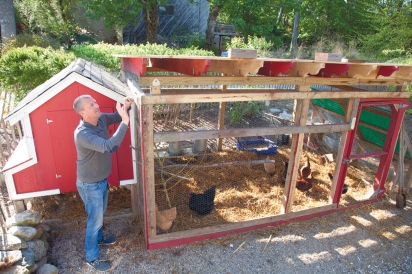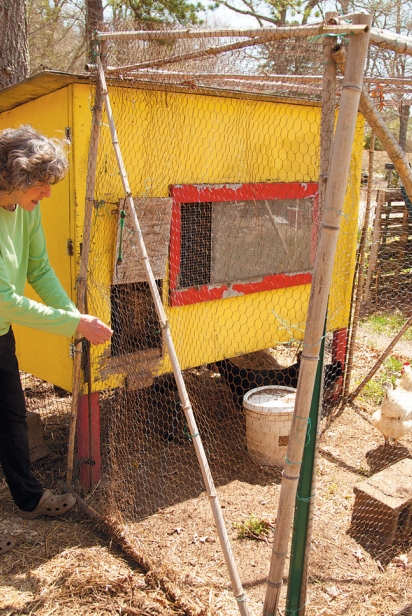Going Home to Roost
“Which comes first, the chickens or the coop”?
It’s a warm spring afternoon, the first day in months that it’s possible to wear a T-shirt outside. Mike Dodge and his wife Kara are relaxing in their Osterville backyard, explaining how their chicken coop came to look like something out of a Dr. Seuss book.
Mike insists Kara said she wanted a “crooked coop”. So while the chicks transformed into pullets indoors, he started assembling materials salvaged from his carpentry business: a window here, a 2-by- 4 there. For someone who makes a living from right angles, Mike felt liberated by the asymmetrical gabled ends, the off-kilter door, the bold red-black-and-gray paint job. Plus, he says, as four year-old Skye tosses handfuls of arugula into the chicken run, “The hens don’t mind.”
Beyond Cape Cod’s front yard fences and hydrangea bushes, you’re almost guaranteed to find a backyard chicken coop in any given neighborhood. Russ Norton, an agriculture and horticulture educator with the Cape Cod Cooperative Extension, says he’s noticed an uptick in backyard coops over the last few years. Each town has different regulations regarding poultry (especially when it comes to roosters), so he recommends starting with your local town hall to find out if zoning bylaws will affect your egg habit.
While there’s a low bar of entry to raising hens, it’s a good idea to read up on the subject and talk with people who have been doing it for a while. “Chickens are livestock, not pets, so they need to be treated differently. Like any other animal, they need checking three times a day and plenty of water. And it’s not like watering a tomato plant,” Norton says.
The best time to get chicks is in early spring, when most hatcheries are supplying them. That way, the pullets (female chicks under one year old) will have full feathers come wintertime. Hens have certain characteristics—some more docile, some better layers—but Norton recommends choosing a species that is suited to cold weather, such as feather-footed Cochins or Rhode Island Reds.
The coop should be well insulated and provide a nest box for every four birds. Hens seek privacy to lay their eggs, so “if there are no nest boxes, you’ll find them here, there, and everywhere,” Norton says. Because hens need at least 14 hours of light per day to lay eggs consistently, he also recommends installing an artificial light to ensure year-round production.
Maureen McGiver started keeping hens at her East Falmouth home about 20 years ago, long before the foodie movement had taken hold. While her neighbors aspired to the Martha Stewart look, she proudly built her red and yellow plywood coop in the front yard, among the raised beds and stone paths.
“I love animals, but only had a dog growing up,” McGiver says, throwing a ball for her two German Shepherds, as ducks root for bugs in the compost and three alpacas gaze at us intently. “Chickens are a gateway animal.”
Over the years, she’s tweaked her design to optimize space and reduce maintenance. Raised up on two-foot stilts, the coop gives the hens shelter in the winter and shade in the summer, plus the daily exercise of flying back inside to roost. Doors on either side of the coop make it a snap to rake out, while the gently sloping roof lets rain and snow slide right off. The run is made of chicken wire and bamboo, and can be adjusted to any size or shape.
McGiver’s coops received so many compliments—even from carpenter friends— that she started selling them, “cheap cheep”: $200 for an unpainted coop and a few starter chicks.
For people short on time (or carpentry skills), buying a pre-made coop is ideal. McGiver isn’t actively selling her coops anymore, but there are plenty of other locally-crafted options. Liz Miles fell in love with a coop she saw while selling her White Lion Baking Company goods at the Falmouth Farmers’ Market in 2013. Designed by Tom Shockey, Sean Dougherty and Nelson Giannakopoulos of Hutker Architects, this sleek-looking henhouse makes great use of space while providing the birds with all the shelter, privacy, and ventilation they need.
Close-meshed recycled wire forms an oval, wrapped with slotted white asphalt the architects repurposed from construction projects. A trapdoor to the straw-covered run on the bottom allows Miles to rake out the straw and retrieve eggs while the hens roam outside. And lest the hens feel like they’re slumming it, two elegant spiral staircases lead to private roosts. To top it all off, this deluxe coop is designed to handle a small garden on the roof, complete with drains in the exterior wall that keep the hens dry.
“Hens are the perfect pets,” Miles says, while eight year-old Standish crawls inside the coop to grab an egg buried in the straw. “They’re so low-maintenance, and they actually feed you.”
While coops can take up very little space, those with room to grow can use their hens to increase soil fertility and eat bugs. Taking a note from Joel Salatin’s Polyface Farm (of Michael Pollan’s Omnivore’s Dilemma fame), Josh and Lauren Leveque cart six Barred Rock hens around their Woods Hole property in a lightweight four-wheeled “egg-mobile”.
Not only do the hens love foraging for insects and munching on fresh grass, Josh says, the soil loves the nitrogen boost it gets from chicken poop. Since it’s such a “hot” fertilizer, he moves the coop every day or two to a new spot. It can be a challenge to find unused space during the growing season, but the Leveques have noticed a marked improvement in soil fertility since they started using the mobile coop method over ten years ago.
“Between the chicken manure and cover crops, you wouldn’t know this was a Cape Cod garden,” Josh says, standing on a hillside field overlooking Vineyard Sound, while kids Noah, Josie and Sadie go on their daily Easter egg hunt.
To prevent predators from getting into the coop (raccoons are able to pull wire mesh apart), Josh surrounds the coop with electric tape powered by a solar battery. In the winter, the Leveques cover the coop with greenhouse-grade plastic, keeping it in place while the hens stay warm and the grass stays green.
Most people build their coops to fit their yards or their hens, but Josh’s fellow Woods Holian Dave Remsen recently retrofitted his coop to handle his six-foot-two stature. Seven hens and five quails share the spacious run, which gives the birds enough room to fly and peck at insects in the straw floor. The slanted roof and walls made of sturdy chicken wire offer plenty of ventilation and protection, but gives Remsen the headroom to come in to feed the birds and clean the run.
The coop itself is a cute red house, connected to the run by a ramp. Remsen mixes a Lactobacillus serum into the coop’s “deep bedding”— at least six inches of straw—to eliminate odor, flies, and maintenance. Over time, the chickens scratch the straw into a fine powder, and Remsen adds it to the compost pile.
With two male quails in the mix, Remsen gets plenty of fertilized eggs, which he incubates indoors. As a close match to the native bobwhite, Remsen considers quails a more sustainable choice over hens—not to mention, they’re prolific layers of exquisite blue eggs.
RESOURCES
Slow Food Martha’s Vineyard Egg-ology Primer: slowfoodmarthasvineyard.org/projects-and-events/chickens-eggs
Brochure from the Cape Cod & Islands Farm Bureau, “Keeping Backyard Chickens”, available by emailing Leslie Spencer at leslie.skyfield@gmail.com


